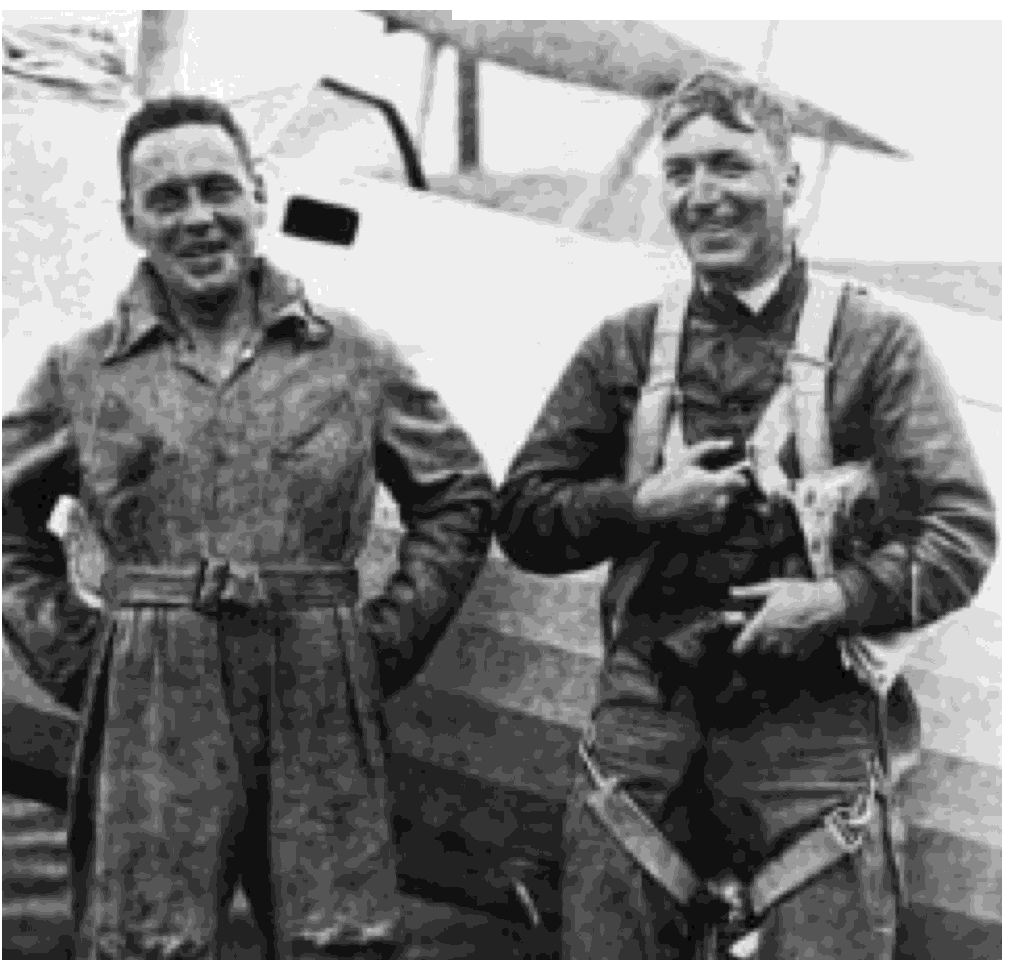
1930-Contin ued
4 June
On the first anniversary of his seaplane alti-
tude record, Lieutenant Apollo Soucek took off from
Anacostia in a Wright Apache landplane equipped
with a Pratt & Whitney 450-hp engine; and, flying to a
new height of 43,166 feet, regained the world altitude
record he had held briefly in 1929.
21 July
Captain Arthur H. Page, USMC, piloted an
02U from a sealed hooded cockpit on an instrument
flight of about 1,000 miles from Omaha, Nebr., to NAS
Anacostia, D.C., via Chicago, Ill., and Cleveland, Ohio;
the longest blind flight to date. Lieutenant Vernon M.
Guymon, USMC, acted as safety pilot and took over
the controls only for the landings after Captain Page
had brought the plane over the fields at 200 feet.
Page and Guymon made long blind flight 1930460434
1 September
In the race for the Thompson Trophy
in Chicago, Ill., Captain Arthur H. Page, USMC, flying
an XF6C-6, was the only military entry. Page gained
and increased an early lead but on the 17th of 20 laps
crashed to his death, a victim of carbon monoxide
pOlsonmg.
5 November
The Director of Naval Research
Laboratory reported that Mr. Leo C. Young and Mr. L.
A. Hyland, while conducting experiments in the direc-
tional effects of radio, had detected an airplane flying
overhead. This led to the formal establishment of a
project at the Naval Research Laboratory for
"Detection of Enemy Vessels and Aircraft by Radio."
UNITED STATES NAVAL AVIATION
1910-1995
79
28 November
The Chief of Naval Operations,
Admiral William V. Pratt issued a new naval air policy,
effective 1 April 1931, which essentially reorganized
aviation and established it as an integral part of the
fleet to operate with it under the direct command of
the Commander-in-Chief U.S. Fleet (CINCUS). The pol-
icy stressed the importance of fleet mobility and the
need for offensive action in protecting against invasion
from overseas, assigned the development of the offen-
sive power of the fleet and advanced base forces as
the primary task of Naval Aviation, and relegated par-
ticipation in coast defense to the status of a secondary
task. To complete the change, the policy also directed
that air stations in strategic naval operating areas
henceforth be assigned to, and operate under the
Fleet; and only such other stations as necessary for
training, test, aircraft repairs and similar support func-
tions would be maintained under shore command.
2 December
The seaplane tender
Aroostook
(CM 3),
one utility and two patrol squadrons of the Battle Fleet
reported for duty to Commander Base Force, thereby pro-
viding that command with its first aviation organization.
1931
8 January
Further development of dive-bombing
equipment and tactics was insured as tests completed
at the Naval Proving Grounds, Dahlgren, Va., showed
that displacing gear eliminated the recently encoun-
tered danger of a bomb colliding with its releasing air-
plane.
9 January
An agreement was announced between the
Chief of Naval Operations, Admiral William V. Pratt and
the Army Chief of Staff, General Douglas MacArthur,
governing the operations of their respective air forces,
which climaxed a long standing interservice controversy
over the division of responsibilities for coast defense.
Under the terms, the functions of the two air forces
were closely associated with those of their parent ser-
vices; the naval air force was defined as an element of
the fleet to move with it and to carry out its primary
mission; and the Army Air Corps as a land-based air arm
to be employed as an essential arm of the Army in per-
forming its general mission, including defense of the
coast at home and at possessions overseas.
22 January
The Navy ordered its first rotary winged
aircraft, the XOP-l autogiro, from Pitcairn Aircraft,
Incorporated.
25 February
A new pilot training syllabus was
issued which added a course in Advanced Seaplane
 |
3 |
 |